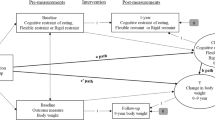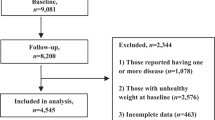Abstract
OBJECTIVE: The aim was to assess long-term changes in food consumption and eating behaviour during and 2 y after dietary counselling in weight-reduced obese men.
DESIGN: Observational study from a randomised controlled trial.
SETTING: Outpatient clinic of a research institute.
SUBJECTS: A total of 36 subjects with complete data on food intake during the study. Subjects were obese (mean body mass index (BMI) 32.8 kg/m2) men aged 35–50 y, recruited by media advertising.
INTERVENTIONS: Dietary counselling was included in 2 months weight reduction with very-low-energy-diet and in 6 months weight maintenance programme, which also included physical activity counselling. This was followed by a 23 months unsupervised follow-up with yearly assessments. Food intake was assessed six times during the study by 4-day food records. Eating behaviour was assessed by Three-Factor Eating Questionnaire (TFEQ).
RESULTS: Increased consumption of low-fat cheese, low-fat margarine, vegetables and high-fibre bread, and decreased consumption of sugar, sausage, high-fat cheese, high-fat margarine, fat products and sweets were observed during dietary counselling. Most of these changes returned later to prestudy consumption level. The relapse in dietary changes was partly associated with scoring low in restraint and high in disinhibition and hunger.
CONCLUSION: In obese men, long-term maintenance of dietary changes was difficult. New ways to ease self-monitoring and increase self-efficacy might be necessary to improve maintenance of dietary changes.
This is a preview of subscription content, access via your institution
Access options
Subscribe to this journal
Receive 12 print issues and online access
$259.00 per year
only $21.58 per issue
Buy this article
- Purchase on Springer Link
- Instant access to full article PDF
Prices may be subject to local taxes which are calculated during checkout

Similar content being viewed by others
References
WHO. Obesity: Preventing and Managing the Global Epidemic. Report of a WHO Consultation on Obesity. WHO Technical Report Series 894, World Health Organisation: Geneva; 2000.
Ayyad C, Andersen T . Long-term efficacy of dietary treatment of obesity: a systematic review of studies published between 1931 and 1999. Obes Rev 2000; 1: 113–119.
Glenny A-M, O'Meara S, Melville A, Sheldon TA, Wilson C . The treatment and prevention of obesity: a systematic review of the literature. Int J Obes Relat Metab 1997; 21: 715–737.
Klem ML, Wing RR, McGuire MT, Seagle HM, Hill JO . A descriptive study of individuals successful at long-term maintenance of substantial weight loss. Am J Clin Nutr 1997; 66: 239–246.
Toubro S, Astrup A . Randomised comparison of diets for maintaining obese subjects' weight after major weight loss: ad lib, low fat, high carbohydrate diet v fixed energy intake. BMJ 1997; 314: 29–34.
National Institutes of Health (NIH), National Lung, Blood and Heart Institute. Clinical guidelines on the identification, evaluation, and treatment of overweight and obesity in adults. Obes Res 1998; 6 (Suppl 2): S51–S209.
Gorder DD, Dolecek TA, Coleman GG, Tillotson JL, Brown HB, Lenz-Litzow K, Bartsch GE, Grandits G . Dietary intake in the Multiple Risk Factor Intervention Trial (MRFIT): nutrient and food group changes over 6 y. J Am Diet Assoc 1986; 86: 744–751.
Henderson MM, Kushi LH, Thompson DJ, Gorbach SL, Clifford CK, Insull W, Moskowitz M, Thompson RS . Feasibility of a randomized trial of a low-fat diet for the prevention of breast cancer: dietary compliance in the women's health trial vanguard study. Prev Med 1990; 19: 115–133.
Hjermann I, Velve Byre K, Holme I, Leren P . Effect of diet and smoking intervention on the incidence of coronary heart disease. Lancet 1981; 12: 1303–1310.
Nordevang E, Callmer E, Marmur A, Holm L-E . Dietary intervention in breast cancer patients: effects on food choice. Eur J Clin Nutr 1992; 46: 387–396.
Borg P, Kukkonen-Harjula K, Fogelholm M, Pasanen M . Effects of walking or resistance training on weight loss maintenance in obese, middle-aged men: a randomized trial. Int J Obes Relat Metab Disord 2002; 26: 676–683.
Henderson M, Freeman CPL . A self-rating scale for bulimia. The ‘BITE’. Br J Psychiatry 1987; 105: 18–24.
Brownell. The LEARN Programs Leader's Guide: Lifestyle, Exercise, Attitudes, Relationships, Nutrition: Making a Weight Loss Program Work. Brownell & Hager: Dallas; 1989.
Stunkard AJ, Messick S . The three-factor eating questionnaire to measure dietary restraint, disinhibition and hunger. J Psychosom Res 1985; 29: 71–83.
Black AE . Critical evaluation of energy intake using the Goldberg cut-off for energy intake:basal metabolic rate. A practical guide to its calculation, use and limitations. Int J Obes Relat Metab Disord 2000; 24: 1119–1130.
AbuSabha R, Achterberg C . Review of self-efficacy and locus of control for nutrition- and health-related behaviour. J Am Diet Assoc 1997; 97: 1122–1132.
Lähteenmäki L, Tuorila L . Three-factor eating questionnaire and the use and liking of sweet and fat among dieters. Physiol Behav 1995; 57: 81–88.
Boschi V, Iorio D, Margiotta N, D'Orsi P, Falconi C . The three-factor eating questionnaire in the evaluation of eating behaviour in subjects seeking participation in a dietotherapy programme. Ann Nutr Metab 2001; 45: 72–77.
Fogelholm M, Kukkonen-Harjula K, Oja P . Eating control and physical activity as determinants of short-term weight maintenance after a very-low-calorie diet among obese women. Int J Obes Relat Metab Disord 1999; 23: 203–210.
McGuire MT, Wing RR, Klem ML, Lang W, Hill JO . What predicts weight regain in a group of successful weight losers? J Consult Clin Psychol 1999; 67: 177–185.
Sarlio-Lähteenkorva S, Rissanen A . Weight loss maintenance: determinants of long-term success. Eat Weight Disord 1998; 3: 131–135.
Crow S, Kendall D, Praus B, Thuras P . Binge eating and other psychopathology in patients with type II diabetes mellitus. Int J Eat Disord 2001; 30: 222–226.
French SA, Jeffery RW, Wing RR . Food intake and physical activity: a comparison of three measures of dieting. Addict Behav 1994; 19: 401–409.
Clark MM, Marcus BH, Pera V, Niaura RS . Changes in eating inventory scores following obesity treatment. Int J Eat Disord 1994; 15: 401–405.
d'Amore A, Massignan C, Montera P, Moles A, De Lorenzo A, Scucchi . Relationship between dietary restraint, binge eating, and leptin in obese women. Int J Obes Relat Metab Disord 2001; 25: 373–377.
Lindroos AK, Lissner L, Mathiassen ME, Karlsson J, Sullivan M, Bengtsson C, Sjöstrom L . Dietary intake in relation to restrained eating, disinhibition, and hunger in obese and nonobese Swedish women. Obes Res 1997; 5: 175–182.
Black AE, Goldberg GR, Jebb SA, Livingstone MBE, Cole TJ, Prentice AM . Critical evaluation of energy intake using fundamental principles of energy physiology: 2. Evaluating the results of published surveys. Eur J Clin Nutr 1991; 45: 583–599.
Heerstrass DW, Ocke MC, Bueno-de-Mesquita HB, Peeters PHM, Seidell JC . Underreporting of energy, protein and potassium intake in relation to body mass index. Int J Epidemiol 1998; 27: 186–193.
Zhang J, Temme EH, Sasaki S, Kesteloot H . Under- and overreporting of energy intake using urinary cations as biomarkers: relation to body mass index. Am J Epidemiol 2000; 152: 453–462.
Hirvonen T, Männisto S, Roos E, Pietinen P . Increasing prevalence of underreporting does not necessarily distort dietary surveys. Eur J Clin Nutr 1997; 5: 297–301.
Goris AH, Meijer EP, Westerterp KR . Repeated measurement of habitual food intake increases under-reporting and induces selective under-reporting. Br J Nutr 2001; 85: 629–634.
Acknowledgements
This study was supported by Emil Aaltonen Foundation, Ministries of Education, and Social Affairs and Health, Juho Vainio Foundation and the pharmaceutical company Leiras (Turku, Finland).
Author information
Authors and Affiliations
Corresponding author
Rights and permissions
About this article
Cite this article
Borg, P., Fogelholm, M. & Kukkonen-Harjula, K. Food selection and eating behaviour during weight maintenance intervention and 2-y follow-up in obese men. Int J Obes 28, 1548–1554 (2004). https://doi.org/10.1038/sj.ijo.0802790
Received:
Revised:
Accepted:
Published:
Issue Date:
DOI: https://doi.org/10.1038/sj.ijo.0802790
Keywords
This article is cited by
-
Relationship between bite size per mouthful and dental arch size in healthy subjects
The Journal of Physiological Sciences (2019)
-
Pharmacological management of appetite expression in obesity
Nature Reviews Endocrinology (2010)
-
Interaction between Disinhibition and restraint: Implications for body weight and eating disturbance
Eating and Weight Disorders - Studies on Anorexia, Bulimia and Obesity (2010)
-
Characterization of obese individuals who claim to detect no relationship between their eating pattern and sensations of hunger or fullness
International Journal of Obesity (2007)
-
Personal Digital Assistants are Comparable to Traditional Diaries for Dietary Self-Monitoring During a Weight Loss Program
Journal of Behavioral Medicine (2007)



